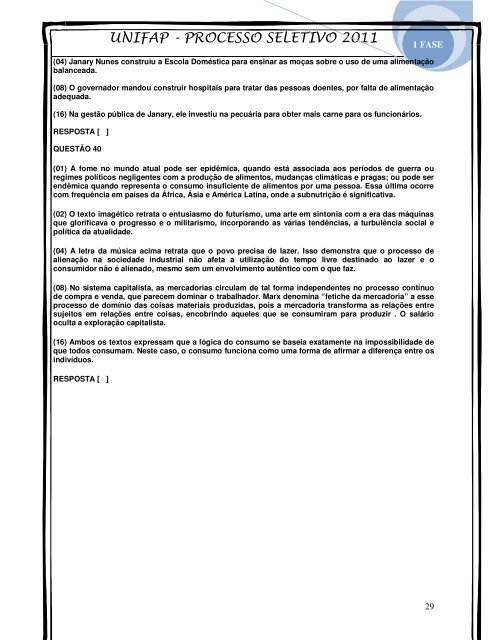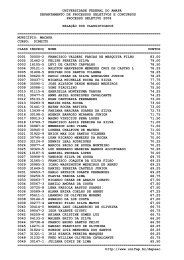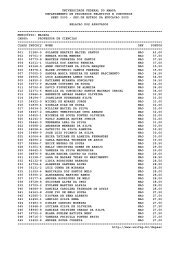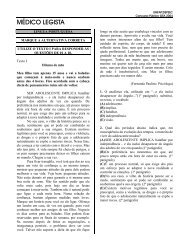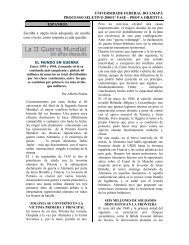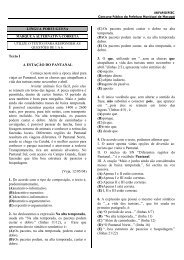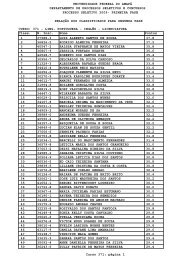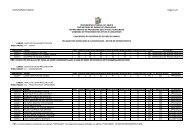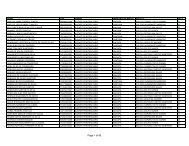UNIFAP - PROCESSO SELETIVO 20111 FASEQUESTÃO 37(01) No mun<strong>do</strong> contemporâneo, a produção cultural e a formação de conceitos estéticos têm si<strong>do</strong>constantemente associadas à organização <strong>do</strong> sistema de produção e consumo. Por isso torna-senecessário que se faça propaganda, direta ou indireta, para que a produção final alcance sucesso.(02) A propaganda é elemento fundamental das sociedades capitalistas, uma vez que é através dela quese impulsiona nos indivíduos a necessidade de consumir merca<strong>do</strong>rias e o consumo dessas merca<strong>do</strong>riascria a necessidade de uma nova produção.(04) A charge acima mostra que o consumo vai moldan<strong>do</strong> o comportamento das pessoas, dan<strong>do</strong> à açãohumana uma direção que tem como objetivo a posse <strong>do</strong>s objetos. Porém, o consumi<strong>do</strong>r não éinfluencia<strong>do</strong> pela necessidade e utilidade – básica ou supérflua – de possuir determina<strong>do</strong> objeto, o quenão desperta atenção para o consumo exagera<strong>do</strong>.(08) A indústria está cada vez mais voltada para a produção de descartáveis e produtos de vida útilreduzida, para atender a sociedade de consumo e o acelera<strong>do</strong> avanço tecnológico que tornam osprodutos, em um curto espaço de tempo, obsoletos.(16) O texto que retrata a música Comida, faixa <strong>do</strong> disco <strong>do</strong>s Titãs de 1987 transformou-se em um hinoda juventude brasileira, pois expressa a insatisfação com as propostas cautelosas, e lembra que épossível associar bens materiais a bens culturais, dinheiro, felicidade, política e prazer.RESPOSTA [ ]QUESTÃO 38A sociedade é consumi<strong>do</strong>ra de produtos, sejam eles: econômicos, políticos, morais e ideológicos, assimà medida que intensificamos o uso ou a compra de objetos ou de ideias, estamos sen<strong>do</strong> consumistas.Dessa forma é váli<strong>do</strong> dizer que:(01) O Plano cruza<strong>do</strong> teve o efeito imediato de assegurar comida para o seguimento pobre da sociedade.(02) À cédula cruza<strong>do</strong> foi acrescenta<strong>do</strong> 02 zeros para que os indivíduos sociais brasileiros ampliassemseu poder de compra.(04) O Plano Cruza<strong>do</strong> <strong>do</strong> presidente José Sarney foi assumi<strong>do</strong> pela população, que tomou para si ocompromisso de ser fiscal <strong>do</strong> governo.(08) O pacote <strong>do</strong> referi<strong>do</strong> plano procurou conter a inflação para o governo poder investir na melhoria daeducação e cultura <strong>do</strong> país.(16) As <strong>do</strong>nas de casa assumiram a condição de fiscal <strong>do</strong> governo para garantir maior poder deconsumo.RESPOSTA [ ]QUESTÕES 39“A alimentação geral <strong>do</strong> povo precisa ser transformada. A refeição em geral é o “cafezinho” com farinha pelamanhã; carne salgada, pirarucu, ou jabá fervi<strong>do</strong> na água e sal, com farinha, ao almoço, pouco diferin<strong>do</strong> o jantar,quan<strong>do</strong> há”. (NUNES, Janary Gentil. Relatório de Atividade <strong>do</strong> Governo – 1944).Relacionan<strong>do</strong> a palavra “comida” da letra da música <strong>do</strong>s Titãs e o texto acima, julgue os itens abaixo.(01) O governa<strong>do</strong>r Janary Nunes investiu na aquisição de alimentos para os funcionários públicoscontrata<strong>do</strong>s.(02) Investiu na primeira escola agrícola de Macapá, para formar técnicos agrícolas para o Território.28
A Technical AppendixA.1 Proofs of Main ResultsProof of Proposition 1.Step 1. We show that in equilibrium, (12) holds with e 1∗ = α(η − i ∗ )I and e 1∗ < i ∗ W.Expected return on equity g(e 1 ,r d ,r c ) must be greater than r d , otherwise banks have noequity and are not allowed to operate. By Lemma 3, Appendix A.2 below, g(e 1 ,r d ,r c ) isthen decreasing in equity e 1 . In equilibrium, first-period equity must therefore satisfy theminimum capital requirement e 1∗ = α(η−i ∗ )I. The balance equation (11) impliese 1∗ =α1−α+αβ+γ (S(rd ∗ )−K) and i 1∗ = η −(1−α+αβ+γ)I (S(rd ∗ )−K). (43)It follows from (43) that e 1∗ < i ∗ W, if and only if(η(1−α+αβ+γ)IW+αI)W > S(r∗ d )−K. (44)Using the fact that S(r d ) < (1−η)W for all r d ≥ 0, a straightforward calculation showsthat (44) is implied by η(1−α)1−η≥ W Iwhich was stipulated in Assumption 1 (2).Step 2. We determine the relationship between quality levels and interest rates at whichan entrepreneur is indifferent between undertaking the production project and investinginto the alternative asset. Since e 1∗ < i ∗ W, we have g ∗ = r A . ConsiderΠ ( i,r c) = W (1+r A ), i ∈ [i,η] (45)which contains the indifference equation (10) as a special case. Setr c (i) := q(1+i)fI−1, i ∈ [i,η], (46)where q denotes the highest possible shock. Then expected profit (1) of entrepreneur iis zero, i.e., Π(i,r c ) = 0 for r c ≥ r c (i). It follows from Assumption 1 (4) that for eachi ∈ [i,η],Π(i,0) ≥ Π ( i,0 ) > W (1+r A ) > Π ( i,r c (i) ) = 0.Since for each i ∈ [i,η], Π(i,r c ) is continuous and (strictly) decreasing in r c < r c (i), itfollows from the Intermediate Value Theorem that (45) has a unique solution 0 < h(i) 0, it is increasing with respect to i and decreasing with respect to r c , h(i)is increasing in i ∈ [i,η]. For each r d ≥ 0, definei E (r d ) := η −1(1−α+αβ+γ)I (S(rd )−K)26


